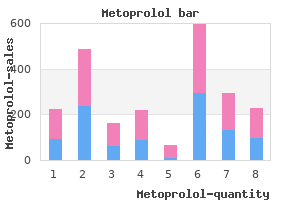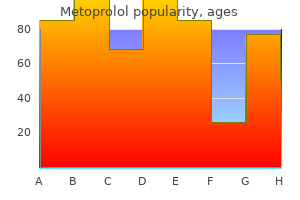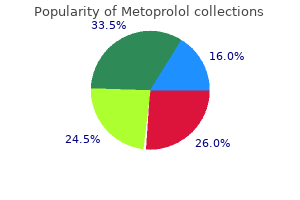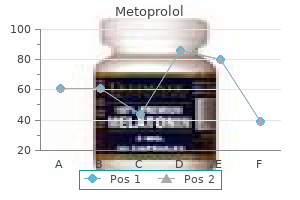

 5100 Springfield St. Suite 108, Dayton, Ohio 45431-1274
5100 Springfield St. Suite 108, Dayton, Ohio 45431-1274Metoprolol
"Generic 50mg metoprolol free shipping, hypertension knowledge test".
By: G. Roland, M.B.A., M.D.
Medical Instructor, Northwestern University Feinberg School of Medicine
The autonomic system can be divided further into the parasympathetic and sympathetic nervous systems blood pressure 50 0 metoprolol 100 mg without a prescription. The preganglionic fibers from S2-S4 form the pelvic splanchnic nerves blood pressure guidelines quality 12.5 mg metoprolol, which provide parasympathetic innervation to the pelvic and abdominal viscera blood pressure bottom number 90 generic 50mg metoprolol with mastercard, which often contain the postganglionic parasympathetic fibers within their walls. The vagus nerve (cranial nerve X) also provides preganglionic parasympathetic fibers to the thoracic, abdominal, and pelvic viscera. In contrast to the parasympathetic system, the preganglionic fibers of the sympathetic nervous system originate between the first thoracic and the second lumbar vertebral levels. These fibers exit the spinal cord from T1 to L2 through the ventral root and course through the corresponding spinal nerve and anterior rami into the ipsilateral sympathetic trunk. The fibers then run medial to the psoas muscle along the anterolateral aspect of the spine. The paired sympathetic trunks are in close proximity to the lumbar arteries and veins, which cross them perpendicularly. The preganglionic fibers can synapse within the ganglia of the sympathetic trunk and send forth postganglionic fibers to the body wall and lower extremities. The preganglionic fibers also may leave the trunk as splanchnic nerves to synapse with the ganglia of the autonomic plexuses of the aorta. The first and largest of these plexuses is the celiac plexus, which contains paired ganglia that lie lateral to the celiac artery. Much of the autonomic innervation to the kidney, adrenal, renal Chapter33 Surgical,Radiographic,andEndoscopicAnatomyoftheRetroperitoneum 779 Cervical ganglia and sympathetic chain Thoracic splanchnic nerves Greater splanchnic nerve Lesser splanchnic nerve Least splanchnic nerve Thoracic ganglia and sympathetic chain Prevertebral plexus Lumbar splanchnic nerves Lumbar ganglia and sympathetic chain Inferior hypogastric plexus Sacral ganglia and sympathetic chain Ganglion impar Sacral splanchnic nerves Pelvic splanchnic nerves Figure 33-35. Some of the autonomic innervation for the testes passes through this plexus and travels caudally with the testicular artery. The renal autonomic plexus is continuous with the celiac plexus and forms adjacent to the renal arteries. It contains the aorticorenal ganglion, which is an inferior extension of the celiac ganglion. Much of the sympathetic innervation to the pelvic viscera travels through the superior and inferior hypogastric plexuses, which are contiguous. The superior hypogastric plexus originates at the caudal extent of the abdominal aorta and extends to the anterior surface of the fifth lumbar vertebra. Extensive retroperitoneal dissection that causes disruption of these plexuses may result in loss of seminal vesicle emission or failure of bladder neck closure resulting in retrograde ejaculation. Confusion may arise with the term splanchnic used for nerves of both the parasympathetic and the sympathetic systems. For clarification, the thoracic splanchnics (greater, lesser, and least), lumbar splanchnics, and sacral splanchnics carry sympathetic fibers from the paired sympathetic trunks to the autonomic plexuses, whereas the pelvic splanchnics carry parasympathetic fibers from the sacral outflow. Somatic Nervous System the somatic sensory and motor nerves of the lower abdomen and lower extremities originate in the retroperitoneum. They form the lumbosacral plexus from the anterior rami of the lumbar and sacral nerves along with T12. The nerves arising from this plexus are in close proximity to the psoas muscle, with the superior nerves piercing the muscle, while the inferior nerves travel medial to the muscle body. This plexus provides the cutaneous sensory innervation to the lower extremities.

Impairment of shear-stress-mediated vasodilation of cavernous arteries in erectile dysfunction blood pressure medication voltaren cheap 100 mg metoprolol with visa. Prediction of cardiovascular events and all-cause mortality with erectile dysfunction: a systematic review and meta-analysis of cohort studies blood pressure how low is too low buy metoprolol 100 mg low cost. Pudendal versus limb nerve electrophysiological abnormalities in diabetics with erectile dysfunction blood pressure chart stage 1 hypertension discount metoprolol online american express. Electrical activity of corpus cavernosum during flaccidity and erection of the human penis: a new diagnostic method Low testosterone associated with obesity and the metabolic syndrome contributes to sexual dysfunction and 28 Defining Priapism Priapism Gregory A. A correct diagnosis of priapism is a matter of urgency requiring identification of the underlying hemodynamics. Both groups have noted that the literature on priapism is composed mainly of small case series and individual case reports and includes inconsistent definitions and methodologies with few long-term erectile function outcome data. Recent case series have included detailed methodology including duration of priapism, cause of priapism, and erectile function outcomes. The basic science on the pathogenesis of priapism and clinical research supporting the most effective treatment strategies are summarized in this chapter. StutteringPriapism(Intermittent) Stuttering priapism is characterized by a pattern of recurrence. Any patient who has experienced an episode of ischemic priapism is also at risk for stuttering priapism. NonischemicPriapism(Arterial,High-Flow) Nonischemic priapism is a persistent erection caused by unregulated cavernous arterial inflow. Whatever the mechanism of injury, the result is a disruption of the cavernous arterial anatomy creating an arteriolar-sinusoidal fistula. The cavernous environment does not become ischemic and cavernous blood gases do not show hypoxia, hypercarbia, or acidosis. This type of priapism, once properly diagnosed, does not require emergent intervention. Normal erectile function has been reported after recovery from the initial event, despite persistence of nonsexual partial erection. In ischemic priapism there are time-dependent changes in the corporal metabolic environment with progressive hypoxia, hypercarbia, and acidosis. The patient typically reports penile pain after 6 to 8 hours, and the examination reveals a rigid erection. The condition is analogous to a muscle compartment syndrome, with initial occlusion of venous outflow and subsequent cessation of arterial inflows. Well-documented histologic changes occur within the corporal smooth muscle as a consequence of prolonged ischemia. Interventions beyond 48 to 72 hours of onset may help relieve erection and pain but have little benefit in preserving potency. Histologically, by 12 hours corporal specimens show interstitial edema, progressing to destruction of sinusoidal endothelium, exposure of the basement membrane, and thrombocyte adherence at 24 hours. The first recorded account of priapism in English medical literature appears in the Lancet and is attributed to Tripe (1845).

Three patients with stable disease received only one or two cycles and survived for 2 or more to 11 months blood pressure levels chart metoprolol 12.5 mg fast delivery. Of note blood pressure 7843 buy metoprolol once a day, two of three patients who ultimately had disease progression received three or four cycles of therapy and underwent surgical consolidation with survival times of 12 and 28 months from chemotherapy blood pressure chart 19 year old purchase metoprolol 100mg online. Thus, 2 of 7 patients (28%) who survived 28 and more than 32 months received significant palliation or cure from the combination. Corral and coworkers (1998) reported on the long-term follow-up of a prospective group of patients treated with bleomycin, methotrexate, and cisplatin. Objective responses were noted in 12 (57%), including 2 of 5 with distant metastases. Thus, this prospective study showed that a multidisciplinary approach to achieve disease-free status could prolong survival. Subsequently Leijte et al (2007) from the Netherlands Cancer Institute reviewed their experience with neoadjuvant chemotherapy in patients with initially "unresectable" penile cancer. The series included 20 patients treated with five different regimens including (1) single-agent bleomycin; (2) bleomycin, vincristine, and methotrexate; (3) cisplatin and 5-fluorouracil; (4) bleomycin, cisplatin, and methotrexate; and (5) cisplatin and irinotecan. The objective responses were evaluable in 19 (1 patient died because of bleomycin toxicity after 2 weeks), with 12 responses (63%, 2 complete, 10 partial). Surgical procedures included treatment of the primary tumor as well as inguinal and pelvic dissections. Among 12 responders, only 9 went to surgery because 2 died of bleomycin-related complications and a third was deemed unfit for surgery. Eight of 9 responding patients taken to surgery (2 were pT0) were free of disease with a median follow-up of 20. The implications of this study are that response to chemotherapy together with an aggressive surgical procedure provides the optimal scenario for significant palliation or potentially cure. In a separate study Bermejo et al (2007) described the surgical considerations and complications among 10 patients who had either a response or stable disease after combination chemotherapy. This cohort of patients exhibited bulky inguinal or pelvic metastases, with the only exclusions being patients with fixed pelvic masses or complete encasement of the femoral vessels. Plastic surgery consultation was obtained for wound coverage, including the insertion of monofilament polypropylene mesh for abdominal wall defects and myocutaneous flaps of the sartorius, rectus abdominis, serratus anterior, and latissimus dorsi muscles. Among 5 patients exhibiting an objective response, 3 were alive and disease free at 48, 50, and 73 months. Two other patients died (1 of disease at 30 months, another of unknown causes at 21 months). Among the 5 remaining patients with stable disease, 3 were dead of disease within 7 months and 1 patient treated with bleomycin died of "failure to thrive" at 8 months. However, another patient treated with paclitaxel and carboplatin who achieved only stable disease was alive and disease free at 84 months. These data appear to reinforce the concept that response to systemic chemotherapy before surgery enhances the chance for long-term survival among those undergoing surgical resection. This provided the rationale for the prospective phase 2 study discussed previously (Pagliaro et al, 2010). Taken together, these data provide evidence that response to chemotherapy improves resectability and survival. Surgery among patients who do not respond to therapy may occasionally be associated with long-term survival but is more often associated with death because of either rapidly occurring locoregional recurrence or Chapter37 TumorsofthePenis 873 distant metastases (Bermejo et al, 2007; Leijte et al, 2007; Pagliaro et al, 2010). Pathologic descriptions and local and regional treatment options are available; however, outcomes and comparisons are limited to case reports and small retrospective series.

We have seen many men referred with late (2 to 5 years) recurrence after radiographic occlusion blood pressure chart uk pdf order metoprolol master card. On presentation they typically have slow-filling veins that become prominent at the end of the day blood pressure medication used for hot flashes purchase generic metoprolol. I believe these recurrences are likely the result of recanalization through the coils because hypertension foods to avoid buy metoprolol online now, unlike with surgical repair, the veins are not ligated and divided. Although often initially successful, I believe that radiographic occlusion is less durable than microsurgical ligation. ComplicationsofVaricocelectomy Hydrocele Hydrocele formation is the most common complication reported after nonmicroscopic varicocelectomy. Analysis of the protein concentration of hydrocele fluid indicates that hydrocele formation after varicocelectomy is caused by lymphatic obstruction (Szabo and Kessler, 1984). At least half of postvaricocelectomy hydroceles grow to a size large enough to warrant surgical excision as a result of the discomfort and growth of the hydrocele to a large size. It is known that men with varicocele have significantly elevated intratesticular temperatures (Zorgniotti et al, 1979; Goldstein and Eid, 1989), and this appears to be an important pathophysiologic phenomenon mediating the adverse effects of varicocele on fertility (Saypol et al, 1981). The development of a large hydrocele creates an abnormal insulating layer that surrounds the testis. This may impair the efficiency of the counter-current heat exchange mechanism and therefore obviate some of the benefits of varicocelectomy (Wysock et al, 2009). Use of magnification to identify and preserve lymphatics can virtually eliminate the risk of hydrocele formation after varicocelectomy (Goldstein et al, 1992; Marmar and Kim, 1994; Glassberg et al, 2008). The management of postvaricocelectomy hydrocele is identical to that for other hydroceles (see Chapter 41). Results Varicocelectomy results in significant improvement in semen analysis in 60% to 80% of men. Reported pregnancy rates after varicocelectomy vary from 20% to 60% (Marmar et al, 2007). A randomized controlled trial of surgery versus no surgery in infertile men with varicoceles revealed a pregnancy rate of 44% at 1 year in the surgery group versus 10% in the control group (Madgar et al, 1995). In our series of 1500 microsurgical operations, 43% of couples had achieved pregnancy at 1 year (Goldstein and Tanrikut, 2006) and 69% at 2 years when couples with female factors were excluded. Microsurgical varicocelectomy results in return of sperm to the ejaculate in up to 50% of azoospermic men with palpable varicoceles (Matthews et al, 1998; Kim et al, 1999; Pasqualotto et al, 2006; Lee et al, 2007a; Ishikawa et al, 2008). Repair of large varicoceles results in a significantly greater improvement in semen quality than repair of small varicoceles (Steckel et al, 1993; Jarow et al, 1996). In addition, large varicoceles are associated with greater preoperative impairment in semen quality than small varicoceles, and overall pregnancy rates consequently are similar regardless of varicocele size. Some evidence suggests that the younger the patient is at the time of varicocele repair, the greater the improvement after repair and the more likely the testis is to recover from varicocele-induced injury (Kass et al, 1987). Varicocele recurrence, testicular artery ligation, or postvaricocelectomy hydrocele formation are often associated with poor postoperative results. In infertile men with low serum testosterone levels, microsurgical varicocelectomy alone results in substantial improvement in serum testosterone levels (Su et al, 1995; Cayan et al, 1999; Younes, 2003; Rosoff et al, 2009; Tanrikut et al, 2011). The testicular artery supplies two thirds of the testicular blood supply, and the vasal and cremasteric arteries the remaining one third (Raman and Goldstein, 2004).

Intraoperative risk factors for infection may include inadequate skin preparation with alcohol/chlorhexidine; prolonged surgical time hypertension untreated generic metoprolol 50 mg on-line. A postoperative variable associated with infection risk is prolonged hospitalization quercetin high blood pressure medication purchase 25 mg metoprolol overnight delivery. A review of studies focusing on penile prosthetic infection between 2000 and 2012 suggested that the most important factors to minimize the risk of device infection include the use of antibiotic-coated prostheses and procedures that decrease inoculating bacteria into the surgical wound pulse pressure 26 order genuine metoprolol line. Although the use of perioperative antibiotics reduces infection, there are no specific guidelines recommending antibiotic protocols, and a wide range of practice patterns exists among urologists performing prosthetic surgery (Wosnitzer and Greenfield, 2011). DeviceMalfunction Device malfunction is becoming less common as prosthesis design improves over time (Bettocchi et al, 2010). A historical prospective study estimating long-term survival rates of first-time implants (N = 2384) found that freedom from mechanical breakage was 79. The most common types of malfunction in a three-piece prosthetic device depend on the manufacturer and include cracks in the silicone tubing, leaks at the site where the tubing connects to the pump, leaks within the cylinder, cylinder aneurysm, and pump disruption (Garber, 2008). Autoinflation, which is discussed elsewhere in this chapter, has been observed to occur in 2. Reservoir-related mechanical malfunction is also rare, and it is unclear whether a functioning reservoir should be replaced during revision surgery to address other issues (Levine and Hoeh, 2012). If malfunction occurs within a few months after implantation, replacement of only the defective component should be considered, especially if this avoids a repeat corporeal incision. After the device has been in place for more than 2 years, complete replacement is indicated (Jain and Terry, 2006). Other options following malfunction include no treatment or device removal without replacement. When choosing the latter, it is important for the patient to understand that because the cavernosal space is now empty, the tunica albuginea will retract, scar tissue will form inside the penis, and the penis will become permanently shorter. OtherComplications Postoperative complications occurring less frequently than infection and device malfunction include erosion, S-shaped penile deformity, poor glans support, and scrotal hematoma. Erosion typically occurs months or years after implantation and can manifest in several different locations. Priapism is defined as a full or partial erection that continues for more than 4 hours beyond intercourse or is unrelated to sexual stimulation (Tausch et al, 2013). If left untreated, the resulting fibrosis is usually distal, extensive, and dense, making it very difficult to dilate with conventional instruments (Wilson and Mulcahy, 2006; Martinez-Salamanca et al, 2011). A review of surgical procedures to facilitate prosthetic implantation and improve outcomes in such situations suggests that scar incision should include a combination of techniques. Some clinicians assume that implantation of a three-piece prosthetic device is contraindicated in such situations because of a perceived increased risk of intraoperative injury. To address these concerns, two studies investigated the use of penile prostheses after radical prostatectomy. In the first, Lane and colleagues (2007) reported that of 115 consecutive patients receiving a three-piece inflatable penile prosthesis after prostatectomy, none experienced intraoperative complications, including injury to the bladder or iliac vessels, with successful blind entry into the retropubic space in all cases. In the second study, Menard and associates (2011) examined surgical complication and patient satisfaction rates in subjects receiving a penile implant after radical prostatectomy and found that the procedure was associated with low morbidity and high satisfaction, especially with respect to erectile function; however, they noted that fibrosis in the retropubic space may necessitate a second incision for reservoir placement or use of a two-piece device instead of a three-piece device. Nevertheless, there have been several catastrophic mishaps related to implantation of a penile prosthesis after prostatectomy, such as placing the reservoir in the bladder, sigmoid colon, or vena cava and injury to the bladder or bowel. In my opinion, the reservoir should always be placed through a separate incision (if the implant is performed via a penoscrotal approach) and placed in a submuscular position.
Order metoprolol without prescription. HEALING MUSIC TO REDUCE BLOOD PRESSURE ❯ SHANKARABHARANAM RAAG ❯.